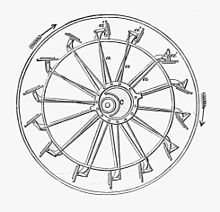Paddle steamer
More advanced paddle-wheel designs feature "feathering" methods that keep each paddle blade closer to vertical while in the water to increase efficiency.European sidewheelers, such as PS Waverley, connect the wheels with solid drive shafts that limit maneuverability and give the craft a wide turning radius.The first mention of paddle wheels as a means of propulsion comes from the fourth– or fifth-century military treatise De Rebus Bellicis (chapter XVII), where the anonymous Roman author describes an ox-driven paddle-wheel warship: Animal power, directed by the resources on ingenuity, drives with ease and swiftness, wherever utility summons it, a warship suitable for naval combats, which, because of its enormous size, human frailty as it were prevented from being operated by the hands of men.[6]Italian physician Guido da Vigevano (circa 1280–1349), planning for a new crusade, made illustrations for a paddle boat that was propelled by manually turned compound cranks.[7] One of the drawings of the Anonymous Author of the Hussite Wars shows a boat with a pair of paddlewheels at each end turned by men operating compound cranks.[8] The concept was improved by the Italian Roberto Valturio in 1463, who devised a boat with five sets, where the parallel cranks are all joined to a single power source by one connecting rod, an idea adopted by his compatriot Francesco di Giorgio.[8] In 1539, Spanish engineer Blasco de Garay received the support of Charles V to build ships equipped with manually-powered side paddle wheels.From 1539 to 1543, Garay built and launched five ships, the most famous being the modified Portuguese carrack La Trinidad, which surpassed a nearby galley in speed and maneuverability on June 17, 1543, in the harbor of Barcelona.[10] In 1787, Patrick Miller of Dalswinton invented a double-hulled boat that was propelled on the Firth of Forth by men working a capstan that drove paddles on each side.[15][16][17][18][19] In Europe from the 1820s, paddle steamers were used to take tourists from the rapidly expanding industrial cities on river cruises, or to the newly established seaside resorts, where pleasure piers were built to allow passengers to disembark regardless of the state of the tide.Paddle steamer services continued into the mid-20th century, when ownership of motor cars finally made them obsolete except for a few heritage examples.The ancient Chinese mathematician and astronomer Zu Chongzhi (429–500) had a paddle-wheel ship built on the Xinting River (south of Nanjing) known as the "thousand league boat".A successful paddle-wheel warship design was made in China by Prince Li Gao in 784 AD, during an imperial examination of the provinces by the Tang dynasty (618–907) emperor.In 1816 Pierre Andriel, a French businessman, bought in London the 15 hp (11 kW) paddle steamer Margery (later renamed Elise) and made an eventful London-Le Havre-Paris crossing, encountering heavy weather on the way.One of the first screw-driven warships, HMS Rattler (1843), demonstrated her superiority over paddle steamers during numerous trials, including one in 1845 where she pulled a paddle-driven sister ship backwards in a tug of war.[30] The large spaces on their decks intended for promenading passengers proved to be ideal for handling the minesweeping booms and cables, and the paddles allowed them to operate in coastal shallows and estuaries.[31] In the Second World War, some thirty pleasure paddle steamers were again requisitioned;[30] an added advantage was that their wooden hulls did not activate the new magnetic mines.More than twenty paddle steamers were used as emergency troop transports during the Dunkirk Evacuation in 1940,[30] where they were able to get close inshore to embark directly from the beach.



Right: Detail of a steamer













TampereFinlandsteamshipsteamboatsteam enginepaddle wheelsAdvanceGreenockblockade-runningscrew propellermarine propulsionRivetedpaddle wheelthrustscrew propulsionsponsonsMurray–Darling systemPS WaverleycapsizingEnterpriseBrownsville, Pennsylvaniasteamboats of the MississippiMark TwainLife on the MississippiDe Rebus BellicisPyroscapheVitruviusodometerHussite WarsGuido da Vigevanocompound cranksTaccolaRoberto ValturioFrancesco di GiorgioBlasco de GarayCharles VcarrackgalleyBarcelonadesalinatorPatrick Miller of DalswintonFirth of ForthsteamshipsPalmipèdeClaude de JouffroyDoubs RiverSaôneWilliam SymingtonLochmabenCharlotte DundasForth and Clyde Canal CompanyRobert FultonClermontAlbanyPS CometHenry BellRiver ClydeHMS Temerairebreaking yardCaptain Henry ShreveGerhard Moritz RoentgenTeam boatsferriesseaside resortsThames steamersSouthend-on-SeaMargateClyde steamersRothsayKöln-DüsseldorferRiver RhineQing dynastyencyclopediaHistory of the Southern DynastiesLiu Song dynastyZu ChongzhiNanjingthousand league boatHou JingLiang dynastyTang dynastySong dynastyJoseph NeedhamBattle of CaishiJin dynastyFirst Opium WarPearl RiverHudson RiverDelaware RiverLe HavreCharles Napier'sAaron ManbySS SavannahSavannah, GeorgiaLiverpoolSiriusLondonIsambard Kingdom BrunelGreat WesternBeaverPacific Northwesthelped open JapanGreat EasterntugboatsEppleton HallPS WaverleyPaddle frigateMatthew C. PerryUSS MississippiBlack ShipsRoyal Navysteam frigatessteam sloopspropellerHMS Rattler (1843)tug of warRussian NavyCrimean WarUnited States NavyMexican WarAmerican Civil Warironclad battleshipsmerchant-navyBoston steamersHMS PlumptonFirst World War
